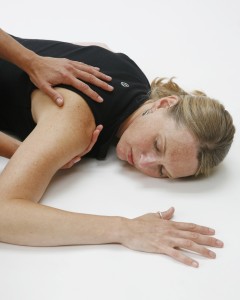 Mind-Body Training for Pain Free Movement
Mind-Body Training for Pain Free Movement
By Lisa Petersen
“Mr. Duffy lived a short distance from his body.”
~ James Joyce (Dubliners)
What do you do when you are wound up like a spring and just can’t relax your muscles? Imagine what it would be like if you could press a reboot button? It might seem counterintuitive, but you need to learn how to control your muscles in order to relax them. Bear in mind that this kind of relaxing is not the same thing as flopping down on the sofa. One is conscious relaxation. The other is not.
What would it be like if you could train your brain to communicate better with your body, and train your body to listen more clearly? It’s like learning to speak a language fluently. Most of us are still stammering beginners when it comes to clearly connecting the mind and the body.
Sensory Motor Amnesia
Stress and repetitive motion have similar affects. Whether we are at the computer for hours or sitting in traffic, our bodies react to life’s daily stresses. Sometimes, we tighten so often, or for so long, that the feedback loop between the brain and muscles goes into a sort of ‘auto-pilot’.
Thomas Hanna, the founder of Somatics called this Sensory Motor Amnesia. In other words, we develop an unconscious habit of tightness. For example, a hairdresser may develop wrist pain. A builder’s back might go into spasm. Someone gardening or working at a computer all day may find it hard to straighten up fully. When muscles become chronically contracted, painful and sore, they lose their flexibility and elasticity. Muscles pull on our bones like the guide ropes on a tent. When our muscles get too tight, they have a profound affect on our posture and how we feel about ourselves.
Imagine you are a human snowman. The top ball, which is the head, has to be balanced over the middle ball, which is the ribs, and both have to be balanced over the lowest ball, which is the pelvis. Any change in the centre of gravity and the snowman will topple.
Deeply Rooted, Deeply Relaxed
Try this. Stand with your feet a little apart and imagine you are standing on the bones of your legs. Invite your leg muscles to lightly hug your bones rather than gripping them. Now, slowly release your chin towards your chest and feel your head hanging like a bowling ball. Your head weighs between 4 and 5 kilos. Feel all that weight release and let it take you downwards. Bend your legs generously as you go so your upper body ends up folded over your lower body. Just go as far as is comfortable. Nod your head ‘yes’ and shake it ‘no’ a few times, and let go of any tension in your neck. Open your mouth, sigh, and relax your jaw. Stay like that for up to a minute. With time, as you practice, you’ll feel your whole spine lengthening as it surrenders to gravity.
When you are ready, bend your knees a little more, press down through your feet and imagine you are making a deeper imprint into the floor as if you were standing on soft sand. Slowly push up, tracking the force from your feet through your ankles, knees, hips, pelvis, through the soft tissue of your belly and chest, up through your spine and finally into your head. Your knees will only fully straighten as your head comes upright. Notice how you feel physically and mentally. With a little practice, you can feel effortlessly relaxed, yet strong and balanced, like a tree deeply rooted into the earth.
Planting a tree is an act of optimism. You nurture it with hope, faith and care, and protect it against the elements. Then you just let it grow. Growth and change happen naturally. Plant your tree. Do it again and again and notice how your life changes.
“If you can sense it and feel it, you can change it.”
~ Thomas Hanne, PHD

![MG_1194-240×300[1]](https://www.positivelife.ie/dev/wp-content/uploads/2011/06/MG_1194-240x3001.jpg)
